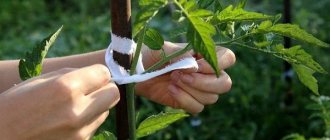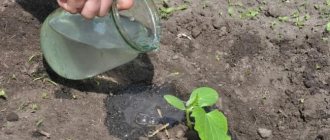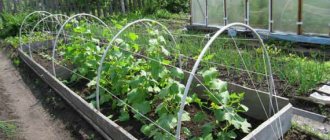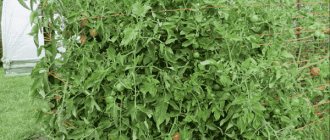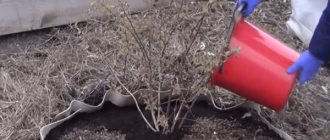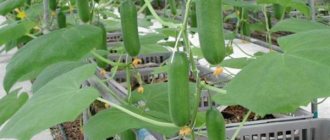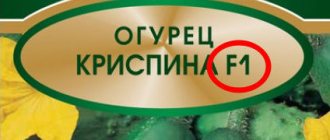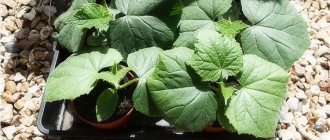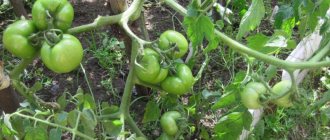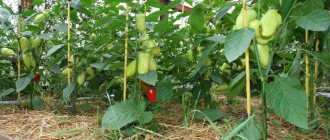The essence of the procedure for pinching cucumbers
Pinching cucumbers has another name - blinding. This operation is performed in order to provoke the formation and promote the rapid growth of lateral shoots from the main stem of the cucumber bush. What is this for and why pinch cucumbers?
With the natural growth of the bush, without human intervention in this process, the plant mainly produces “single” male shoots, characterized by the fact that when the flower withers on them, no fruit sets. Needless to say, such a plant will respond to even the most careful care with a meager harvest.
For full fruiting, each plant must have a paired set of female and male inflorescences and the creation of female inflorescences is the actual task of such a method as pinching cucumbers.
An important condition for the procedure is the preservation of healthy leaves of the seedlings. The value of the leaf is in its unique combination of microelements, which are then transferred into growing vegetables. For the same reason, it is necessary to promptly remove leaves that are rotten, damaged by insects, or beginning to turn yellow.
If the cucumber blinding algorithm is correctly followed, we end up with the following type of bush: a long vine with short shoots coming from the stem. Experienced owners go further and do not allow the shoots of the lower sinuses to grow, removing them from the base. The same procedure is applied to the stepsons that form in the leaf rosette and the small cucumbers that appear in the lower four leaves. This type of pinching of cucumbers in open ground or in a greenhouse preserves the plant’s strength for abundant fruiting.
Formation of varietal cucumbers
With the male type of flowering, characteristic of varietal crops, the top is removed, helping the plant to dissolve the side vines. Depending on the variety and weather conditions affecting the height of the sprouts, this pinching of cucumbers is carried out after the appearance of 4–6 true leaves. In addition, lower shoots, flowers that touch the ground and cotyledons are removed.
Related article:
Saving cucumbers from aphids
In this way, the young plant is protected from harmful bacteria and fungi that may be in the soil. After pinching is done, the cucumbers become stronger, develop their crown more actively and form ovaries on the stepsons. It is advisable to “feed” the plant with phosphate fertilizers by dissolving 60 g of phosphate in 10 liters of water. For 1 m² of garden you will need 3 liters of stimulant.
Before pinching the top, you need to wash your hands with soap and disinfect sharp scissors. The operation is recommended not only for trellis plantings, but also for the “spread out” method. When the stepsons grow, they can be tied to a horizontally stretched support so that the greens do not lie on the ground. This will avoid unsightly yellow “barrels”, irregular shapes and pest damage.
Related article:
Cucumber Competitor - description and characteristics of an early ripening variety
The top of the main stem is cut slightly below the leaf rosette, as shown in the photo:
In the future, the cucumber vine will develop only to the sides. After 3–4 leaves appear on the stepsons, they are also pinched, promoting the growth of the crown. Too long lashes deplete the root system, which leads to a decrease in the number of ovaries or their fall. Cucumbers that have reached a standard size must be plucked regularly, otherwise the yield of the vine will decrease.
Proper pinching
Even when the seedlings are just transferred from the seedling box to the ground, it is already taken into account that in the future the bushes will need to be pinched. The optimal distance between cucumbers is determined in advance to be no less than 30 cm, and a trellis for future garter is installed near each vine. It is customary to tie up cucumber seedlings 12-15 days after planting, and it is recommended to use soft copper wire or thick twine.
Hybridity or purity of the variety, type of plant according to the type of pollination - all these nuances are taken into account when the question arises of how exactly to pinch cucumbers, and whether it should be done at all. Since there are a huge number of varieties of these bushes, it is conventional to divide them into two main categories: parthenocarpic (self-pollinating) and insect-pollinated. The following differentiation of the crop occurs according to the timing of fruit ripening: Renne, mid- and late-ripening varieties.
The basic method of how to properly pinch cucumbers can be used both indoors and outdoors:
- first they make a garter, and the attachment of the cotyledon leaves is avoided, and the application of the twine itself is not done tightly, just to secure the top in the desired position;
- six sheets are counted from the bottom and the crown is trimmed above the sixth sheet;
- in cucumbers pollinated by insects, only weak, non-viable shoots are removed, leaving four growing points;
- hybrids retain 3 strong shoots;
- with the beginning of flowering, the formation of the bush stops.
See also
Do I need to soak processed cucumber seeds before planting and can I Read
Leaves need to be preserved as much as possible, but only if they are completely healthy and undamaged, so you need to carefully pinch cucumbers in open or closed ground, without pinching the leaves with twine or twisting them with wire. You should also pay attention to the presence of insects and remove those parts of the plant that have been severely damaged by their activity.
Important Tips
- Since cucumbers have a weak root system, you need to be careful when working with them;
- It is necessary to cultivate and fertilize the soil;
- Remove male shoots;
- Use only clean and sharp tools;
- If you notice leaves or branches starting to wilt, remove them immediately;
- After pruning, stumps should not be left, as this can lead to plant disease.
Pinching in open ground
Whether it is necessary to pinch cucumbers in open ground again depends on the plant variety, which in turn is characterized by the length of the side shoots. If there are scanty branches, it is not necessary to pinch cucumbers in open ground. If the shoots are of medium and high length, the top is removed as soon as the central shoot reaches a meter in length. The development of shoots on other shoots is also corrected.
When gartering is impossible due to the fact that the planting was done too densely, pinching the cucumbers means removing the growth points located on top of the fourth leaf on the main shoot and on top of the second on the side shoot.
Hybrids are blinded a little differently - their side shoots and all axillary shoots are removed.
Insect-pollinated cucumbers, as those most in need of care, require pinching with mandatory preliminary tying, so they are placed in the garden at a sufficient distance from each other and a trellis is installed in advance. Step-by-step instructions for blinding such varieties include strict adherence to important conditions:
- distance between seedlings – from 30 to 45 cm;
- tying is carried out no earlier than the 10th and no later than the 15th day from planting the seedlings;
- From the bottom of the bush, not only the shoots are removed, but also the very first ovaries, because the developing cucumbers draw all the juices of the plant onto themselves and do not allow the upper ovaries to form;
- Be sure to preserve all healthy leafy greens.
The liana is modeled in this way:
- The top is cut off above the 6th leaf, and the side branches can be tied up so that they curl further;
- all but the 3 most viable sprouts are cut off;
- The shoots are inspected, and all weak ovaries are removed and no more than 4 are left on each shoot.
Late varieties of these vegetables require the closest attention - when growing such cucumbers, pinching is carried out in any case.
When to start pinching cucumbers
In the spring we sowed or planted our cucumbers - seeds or seedlings. Seedlings should not be kept in greenhouse conditions, as this will result in less stress for the plant when transplanted into the ground. The appearance of 1-2 true leaves is enough.
After planting the seedlings, mulch the soil to retain moisture and prevent weeds. At first, depending on the soil, cucumbers are watered daily. When the soil dries out and there is a lack of moisture, the cucumber leaves noticeably darken and the edges of the leaves become sharper.
At the beginning of summer, the plants have already grown and you can start tying them up and shaping them, and, accordingly, pinching them.
By pinching, we remove the emerging ovaries and side shoots of cucumbers at a height of 30-40 cm from the ground.
Blinding parthenocarpic varieties
Self-pollinating cucumbers are completely independent and are most often suggested for sowing in the regions of the middle zone. Growing them does not require much effort in terms of modeling the pattern of the vine, since the bush quickly throws out the required number of shoots, on which over time, from almost every flower, a full-fledged ovary is formed.
Why even pinch cucumbers in open ground if the yield does not depend on it? The fact is that by letting the cucumber vine grow as it pleases, there is a risk of getting a wild, elongated and completely useless plant, randomly strewn with unformed fruits. Therefore, by adjusting growth, the gardener at the same time improves the quality of each fruit unit. When should you pinch these cucumbers? Just like any others, between 10 and 15 days from the moment of planting the seedlings.
Scheme on how to pinch cucumbers in open ground if they are self-pollinating varieties:
- the bush is tied to the supporting element;
- when the main stem reaches a height of 50 cm, all shoots from below are removed, along with flower rosettes and small cucumbers - this will become a blinding area;
- on top of the designated area, the lateral lashes growing above the first leaf are stopped;
- at a distance of 40-50 cm from the blinding area, leave the formed ovary and 2-3 leaves;
- further, at a distance of already a meter, four shoots with 2-3 ovaries are preserved on each;
- even higher, after 40-50 cm, on the same number of shoots you can save 4 cucumbers and 3-4 leaves.
See also
How to properly plant cucumbers in a greenhouse step by stepRead
Often, after the manipulations have been carried out, the plant begins to grow even more intensely - in this case, the vine is thrown over a bar stuffed on top of the support and the bush grows further down. When 25-30 cm remains to the ground, the growing point of the cucumber is cut off and it stops growing in length.
Features of caring for greenhouse cucumbers
Sometimes cucumbers in a greenhouse do not grow as actively as we would like. There may be several reasons for this phenomenon. Below we will look at them in more detail:
- One of the likely reasons for poor growth of greenhouse cucumbers may be incorrect selection of varieties. It is known that all cucumbers can be divided into 2 large groups: non-seed-pollinated and parthenocarpic. The second type is grown in greenhouses without any problems, while pollinated plants require the attraction of certain insects. To help pollination, prepare a solution of 1 tbsp. honey, 1 liter of warm water and 0.1 g of boric acid. Spray your cucumbers with the resulting mixture, and leave the doors and windows of the greenhouse open so that the bees can freely enter it. There is also an alternative method of pollination - carrying out the procedure yourself. Pick a male flower from the shoot and touch it with the core of the “female” flower. Treat all the inflorescences on the cucumbers in this way.
- The second reason why cucumbers in a greenhouse grow slowly and develop poorly can be considered to be an incorrect regime for maintaining ambient temperature and humidity. It is known that cucumbers love warmth. The most favorable temperature for their growth is considered to be 20-25°C. At temperatures below 15°C, the culture develops slowly, and practically no ovaries form on the stems. Excessive heat will also not benefit plants; at ambient temperatures above 33°C, their pollen will become incapable of fertilization. It is better to water with water whose temperature is approximately the same as that of the soil in the greenhouse.
- Poor growth of greenhouse cucumbers may be due to improper soil composition. If, for example, the soil is oversaturated with nitrogen fertilizers, plants may experience a deficiency of other nutrients: potassium or phosphorus. You can conclude that there is an excess of nitrogen based on the condition of the branches and flowers: too rapid growth of shoots and the formation of a large number of barren flowers on them indicate that the earth is oversaturated with nitrogen fertilizers. In this case, it is necessary to add a solution of wood ash or superphosphate to the soil. Ash is dissolved in water in the following proportion: for 1 glass of ash there should be 10 liters of warm water. To prepare superphosphate extract, 2 tbsp. the substances are diluted in the same amount of boiling water. After 2-3 days, superphosphate is applied under the roots of the cucumbers.
- Poor yield of greenhouse crops may be due to high planting density. Excessive density of plants leads to the fact that they do not receive enough air and light. This, in turn, causes poor formation of ovaries. Among other things, a high concentration of plants in a small area can lead to a lack of nutrients for each individual bush.
- The presence of a large number of unnecessary leaves and shoots is another reason for poor yields. Only timely and correct pinching of cucumbers will help solve this problem. If you do not want to spend time forming bushes, grow single-stem plants or crops that produce a small number of shoots in the greenhouse.
Do hybrid cucumbers require pinching?
The task of breeders involved in breeding unpretentious varieties of crops that are convenient for home cultivation has long been to create species that do not require pinching at all. These varieties belong to the single-stem type - let's take Sarovsky F1 as an example, or to hybrid derivatives that produce a small number of underdeveloped shoots. These varieties were given the name: Valdai F1, Dubler F1, Vyuga F1.
On the main (or only) stem of cucumber hybrids there is a sufficient number of fruitful inflorescences, but in some cases it is necessary to provoke their appearance, for which pinching is used. When purchasing seeds of one of the hybrid varieties, you need to check with the seller about the need for this procedure.
Pinching of hybrid varieties has its own pattern:
- side lashes need to be removed at the stage of formation of the fifth leaf;
- Having counted the next 6 leaves, you need to pinch off a little at the side shoot, leaving about a quarter of a meter on the bush;
- the next pinch is done after another 6 leaves, but leaving about half a meter of the shoot;
- Finally, after waiting for six more leaves to form, pinch off the top.
- gardeners with extensive experience are unequivocally confident that no matter what variety ends up in the ground, pinching is necessary until the barren flowers are completely removed, since the presence of “male” flowers is one of the reasons why cucumbers taste bitter. Accordingly, the more barren flowers take away the strength from the cucumber stem, the more clearly the bitterness will appear.
Scheme for pinching a cucumber bush
Already when transplanting seedlings from a box into the ground, it is necessary to take into account that in the future they will need pinching. Therefore, the distance between the bushes is maintained at least 30 centimeters, and supports are installed in advance. When a gardener begins to form cucumbers, he must take into account several nuances: the bush is bee-pollinated or self-pollinated, it is a hybrid or a varietal plant.
Insect-pollinated varieties and hybrids
Step-by-step method for pinching insect-pollinated cucumbers:
- Above the 5-6th leaf, the top is cut off: shoots will form from the lateral sinuses, which are then tied to a support.
- No more than 3 lashes are left on the bush.
- On the side shoots, 4 ovaries are allowed, the rest are removed.
See also
How to pollinate cucumbers yourself at home and in a greenhouse
Read
Hybrids are also subjected to shaping. There are only a few hybrid varieties that do not require removal of the main shoot, for example: Valdai F1, Metelitsa F1, Vyuga F1. Their main stem is well developed, but the side branches are weak and cannot produce a high-quality harvest. The remaining hybrids are formed in the same way as varietal cucumbers.
Procedure in a greenhouse
Cucumbers intended for planting in a greenhouse are formed into one stem, removing the shoots so that they contain no more than two fruiting inflorescences. Varieties Ritual, Malachite, Topolek, that is, varieties that are actively involved in branching, are organized in exactly this way.
On the contrary, varieties with conditionally degraded side shoots require attention to this procedure. If the plant grows into a single stem on its own, and the branches do not reach an obstructive length, it is not recommended at all.
Pay attention to the varieties to which this warning applies: April, Zozulya, Dublyor. All are labeled F1 and require minimal adjustments.
Among owners who emphasize growing crops in greenhouses, a popular method allows harvesting within 5-6 months. For this method, you need to pinch the top of the part of the ogudina located on the wire or crossbar of the trellis, and send two branches down the support, on which more shoots will subsequently grow. They do not need to be touched, as the flowers that appear on the vines will become fruit-bearing.
Do not forget about the organization of the so-called blinding area, which forms at a distance of half a meter from the ground. There should be no ovaries or side shoots in the area included in this zone. You should also regulate the mass of leaf formation - at least one full-fledged healthy leaf should remain for each ovary.
Why do you need a pinch?
There is an opinion among some gardeners that in order for cucumbers to bear fruit well, it is not necessary to pinch them. Perhaps in some cases this is true, since much depends on the characteristics of each variety. But most often barren flowers grow on the vines that form without pinching. They are not able to set fruit and fall off after drying.
Pinching allows the bush to form female flowers produced on the side shoots. In addition, it will prevent the occurrence of various diseases that form in thickened plantings. And also the fruits, set on the side branches, are formed abundantly, in a beautiful (not hook-shaped) configuration, for the most part, without bitterness.
How to form a bush
If we are talking about self-pollinating varieties, the procedure is different from blinding old varieties. This is due to the fact that female inflorescences appear in large numbers on the stem of hybrids, while male inflorescences are almost absent or not at all. Hybrids are pinched only after the lash reaches the top of the support and begins to move downwards.
Attention!
The formation of bushes should occur in the first half of the day in calm, dry weather. This is a necessary condition for the wounds from the procedure to heal and dry out.
Basic rules for forming a bush:
- You can't be late - there's no need to hesitate, especially with tall sprouts. At the same time, pinch only the tops, and not the lashes, the length of which reaches 20-30 cm. If you do not follow this rule, you can injure the crop.
- Cut, not break - sharp tools are needed for cutting. You can’t break it, otherwise wounds will form that will take a long time to heal.
- Remove empty flowers - if there are a lot of fruits with empty inflorescences, then it is necessary to dry the soil a little. In this case, the nutritional components will be transferred to the greens.
- During the collection of fruits, the lashes must not be touched - during the collection of cucumbers, it is forbidden to change the location of the upper branches, as well as turn them to the other side. Otherwise, the plant will not restore its previous position, but will die.
- Remove yellowed leaves - you constantly need to tear off the yellow foliage, which is located below the fruiting zone: there should be no more than 3 leaves left before it.
- Get rid of large leaves - if large leaves appear closer to the trellis, then it is better to remove them, since they interfere with the flow of sunlight to the lower leaves.
- Cut flush - when pruning foliage, do not leave stumps, because they can cause the bush to get sick.
- Carry out the work in the morning - you need to pruning and trimming before lunch, so that the wounds dry out by the evening.
Compliance with these rules guarantees high yields.
In one stem
If cucumbers grow in a greenhouse, then you do not need to wait for the stem to stretch. The process of forming a bush into one stem may seem complicated, especially to a beginner, but if you regularly monitor the crop and notice the appearance of new shoots in time, then everything will be simple.
Attention!
The bush should be inspected weekly for the presence of new leaves.
The correct procedure looks like this:
- 1.5 weeks after planting cucumbers in the garden, you need to tie up the bush by pulling a rope;
- in the locations of the axils, where the first 4 leaves are located, get rid of flowers and sprouts;
- After 5 more leaves appear, remove new side branches.
You should stop working when the stem exceeds the height for tying. In this case, pinch the top. To form the correct bush, you will need a sharp pruner.
In several stems
This method is suitable for bushes with several side branches. The formation goes like this:
- Pull the main stem and secure it with a garter;
- pull the side branches to the main stem as soon as the first ovaries appear. Until this moment, do not touch them;
- tie the crop to the main stem with tendrils growing from the shoots.
